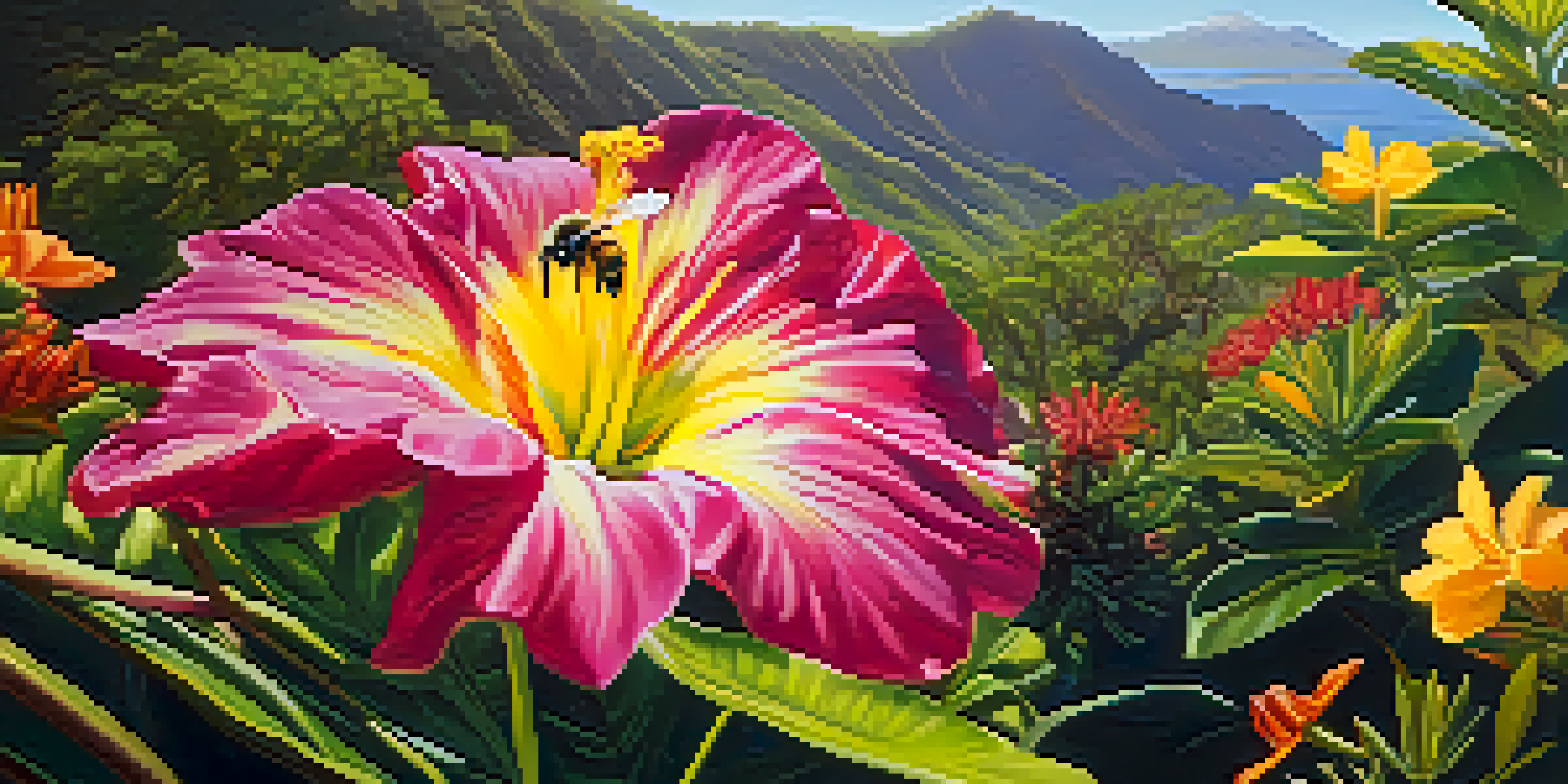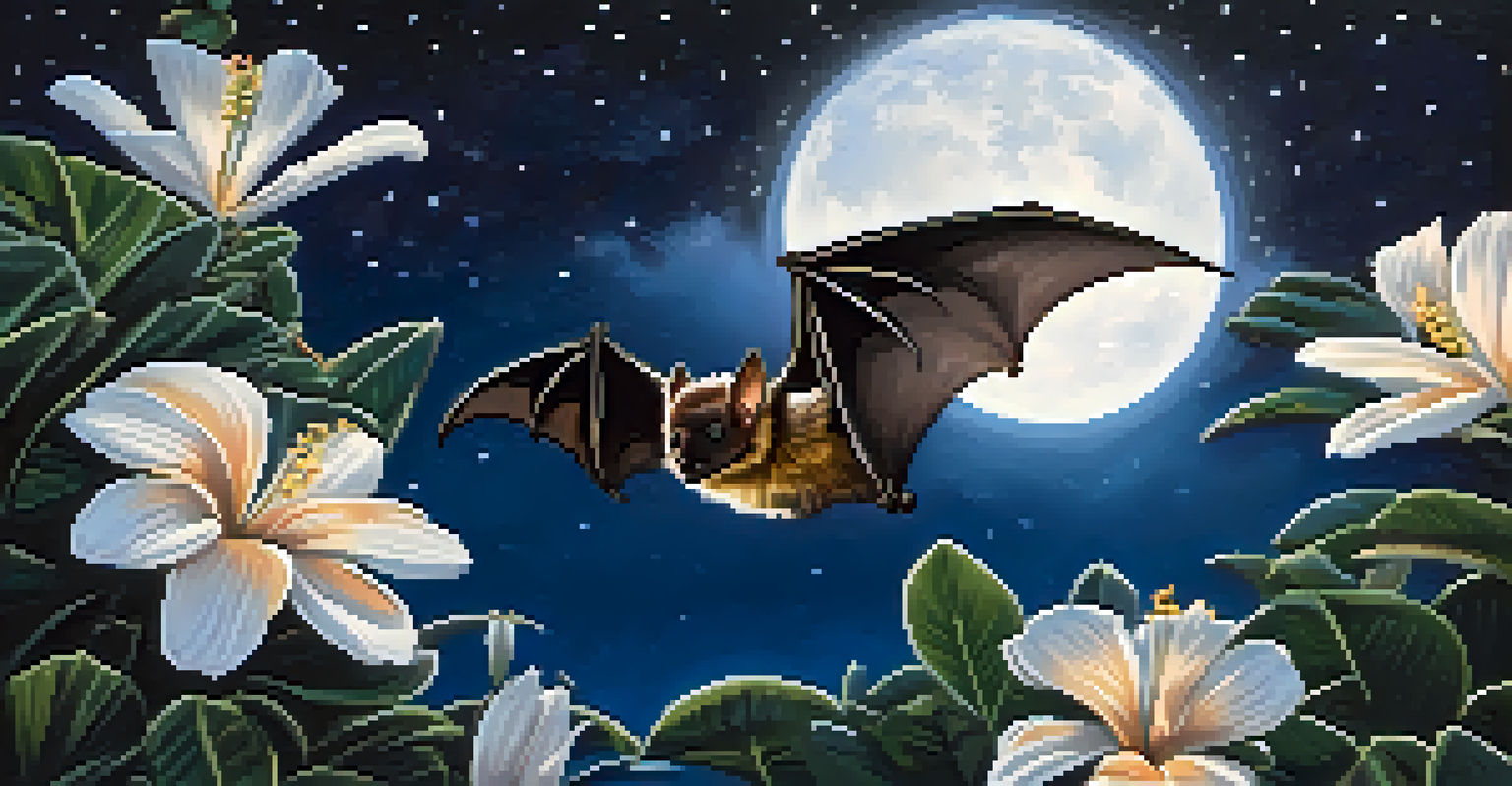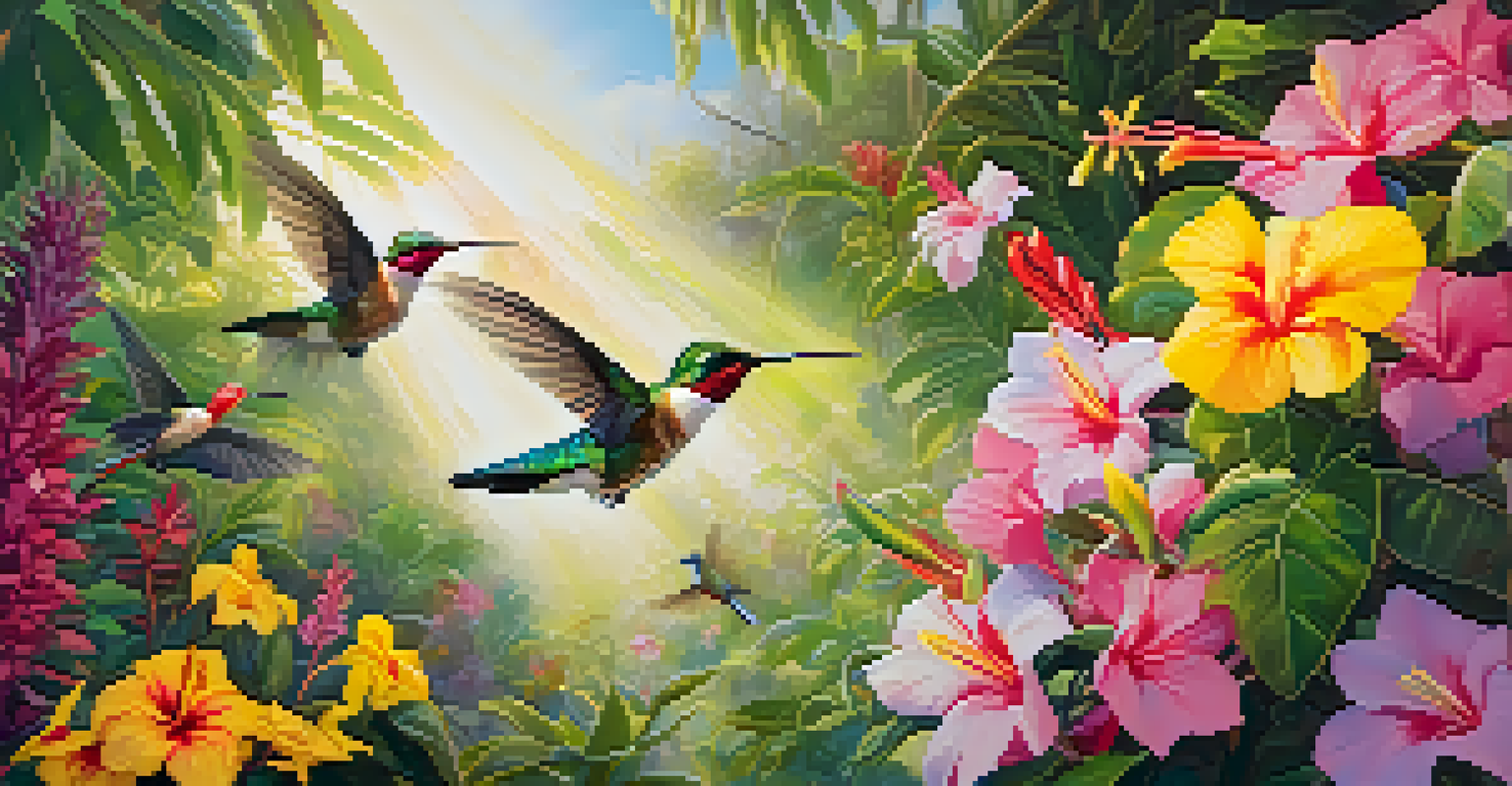Hawaii's Unique Pollinators: Bees, Birds, and Bats

The Importance of Pollinators in Hawaii's Ecosystem
Pollinators are essential for the health of Hawaii's ecosystems, helping to fertilize plants and ensure the growth of fruits and seeds. This intricate dance between pollinators and plants sustains not only native flora but also the diverse wildlife that relies on these plants for food and habitat. With many species found nowhere else on Earth, Hawaii's unique pollinators play a crucial role in maintaining biodiversity.
The hum of bees is the voice of the garden, a reminder that life exists in the most delicate of balances.
In Hawaii, the connection between plant and pollinator is especially significant, as many native plants have evolved alongside their pollinators. This relationship is a beautiful example of co-evolution, where each species influences the other's development. For instance, certain Hawaiian plants have adapted to attract specific birds or insects, ensuring their reproductive success through targeted pollination.
The loss of pollinators can disrupt this delicate balance, leading to the decline of native species and affecting the entire ecosystem. As such, understanding and protecting these vital creatures is imperative for preserving Hawaii's natural heritage and promoting ecological health.
Native Bees: The Unsung Heroes of Pollination
Hawaii is home to a variety of native bee species, many of which are unique to the islands. These bees, such as the yellow-faced bee, are crucial for pollinating native plants and ensuring their survival. Unlike the well-known honeybee, Hawaii's native bees have adapted to the unique climate and flora of the islands, showcasing remarkable diversity.

The yellow-faced bee, for example, is a solitary bee that nests in the ground and has a particular affinity for native Hawaiian flowers. This bee's specialized behavior highlights the importance of preserving native habitats, as these bees rely on specific plants for food and nesting sites. Protecting these environments ensures that these pollinators can thrive and continue their essential work.
Pollinators Boost Hawaii's Biodiversity
Native pollinators are vital for fertilizing plants, ensuring the growth of fruits and seeds, and maintaining the health of Hawaii's unique ecosystems.
However, native bees face significant threats from habitat loss, invasive species, and climate change. By raising awareness and implementing conservation efforts, we can help safeguard these unsung heroes and their vital role in Hawaii's ecosystems.
Hummingbirds: Nature's Tiny Aerial Pollinators
While Hawaii lacks native hummingbird species, several types have been introduced, adding a new layer to the island's pollination landscape. These small, agile birds are remarkable pollinators, capable of transferring pollen as they flit from flower to flower in search of nectar. Their unique adaptations, such as rapid wing beats and long beaks, allow them to access nectar from various flowering plants.
Pollinators are essential to our food supply and the health of our ecosystems. Without them, we would be lost.
Introduced hummingbirds, such as the Anna's hummingbird, have adapted well to Hawaiian environments, helping to pollinate many non-native plants. Interestingly, some Hawaiian flowers have evolved to attract these birds, demonstrating the dynamic relationship between pollinators and plants. This adaptability showcases the resilience of Hawaii's ecosystems, even in the face of changes brought about by human activity.
Despite their contributions, introduced hummingbirds can also pose challenges to native species. As we celebrate the role of these birds in pollination, it’s important to balance their presence with efforts to protect Hawaii's unique flora and fauna.
Bats: The Nighttime Pollinators of Hawaii
Hawaii is also home to a unique species of bat known as the Hawaiian hoary bat, which plays a significant role in nighttime pollination. These bats are not only important for controlling insect populations but also for pollinating certain flowers that bloom at night. Their ability to navigate in the dark allows them to access nectar-rich plants that other pollinators may miss.
The Hawaiian hoary bat primarily feeds on nectar and fruit, making them essential for the reproduction of various native plants. As they feed, they inadvertently transfer pollen from flower to flower, ensuring the plants can produce seeds and fruit. This nocturnal activity is crucial for the overall health of Hawaii's ecosystems, particularly for plants that have evolved to rely on night pollinators.
Threats to Native Pollinators
Invasive species, habitat loss, and climate change pose significant threats to Hawaii's native pollinators, disrupting the delicate balance of the ecosystem.
Despite their importance, Hawaiian hoary bats face numerous threats, including habitat loss and climate change. By understanding their role in the ecosystem, we can advocate for conservation efforts to protect these unique nighttime pollinators and the delicate balance of life in Hawaii.
The Threat of Invasive Species to Pollinators
Invasive species pose a significant threat to Hawaii's unique pollinators, disrupting the delicate balance of the ecosystem. These non-native plants and animals often outcompete native species for resources, leading to declines in native pollinators. For example, invasive plants may not provide the right kind of food or habitat that native bees and birds require for survival.
The introduction of invasive insects can also harm native pollinators by preying on them or competing for food sources. This can have a ripple effect throughout the ecosystem, as the decline of one species can impact others that depend on it. The loss of native pollinators, in turn, threatens the plants they help to reproduce, creating a cycle that can lead to further biodiversity loss.
To combat these challenges, conservation efforts are focused on controlling invasive species and restoring native habitats. By prioritizing the protection of Hawaii's unique pollinators, we can help ensure the resilience of the islands' ecosystems against the pressures of invasive species.
Conservation Efforts to Protect Pollinators
Efforts to conserve Hawaii's unique pollinators are vital for maintaining the health of its ecosystems. Organizations and local communities are actively working to restore native habitats, control invasive species, and raise awareness about the importance of pollinators. These initiatives not only benefit the pollinators themselves but also promote the overall biodiversity of the islands.
One effective strategy involves planting native plants that provide food and habitat for pollinators. By creating pollinator-friendly gardens and landscapes, individuals can contribute to the conservation of these vital species. Educational programs also play a crucial role in informing the public about the significance of pollinators and how they can help protect them.
Community Action for Conservation
Individuals and organizations can play a crucial role in protecting Hawaii's pollinators through habitat restoration, community initiatives, and education.
Moreover, collaborations between government agencies, researchers, and community groups are essential for implementing effective conservation strategies. By working together, we can ensure a brighter future for Hawaii's unique pollinators, helping to safeguard the islands' rich natural heritage for generations to come.
How You Can Help Hawaii's Pollinators
You don’t need to be an expert to make a difference for Hawaii's pollinators. Simple actions, such as creating a pollinator-friendly garden, can have a huge impact on their populations. By planting native flowers and providing water sources, you can help create a welcoming environment for bees, birds, and bats alike.
Additionally, supporting local conservation efforts and participating in community initiatives can amplify your impact. Many organizations offer volunteer opportunities, educational workshops, and events focused on protecting Hawaii's unique ecosystems. By getting involved, you not only contribute to conservation but also learn more about the fascinating pollinators that call Hawaii home.

Lastly, spreading awareness about the importance of pollinators can inspire others to take action. Share your knowledge with friends and family, and encourage them to join in the effort to protect these vital creatures. Together, we can create a movement that ensures the survival of Hawaii's unique pollinators for future generations.